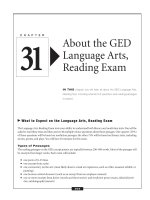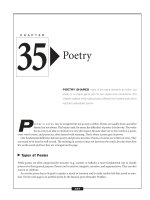About the GED Language Arts, Reading Exam
Bạn đang xem bản rút gọn của tài liệu. Xem và tải ngay bản đầy đủ của tài liệu tại đây (160.32 KB, 14 trang )
What to Expect on the Language Arts, Reading Exam
The Language Arts, Reading Exam tests your ability to understand both literary and nonfiction texts. You will be
asked to read these texts and then answer 40 multiple-choice questions about those passages. One-quarter (25%)
of those questions will be based on nonfiction passages; the other 75% will be based on literary texts, including
stories, poems, and plays. You will have 65 minutes for this exam.
Types of Passages
The reading passages on the GED, except poems, are typically between 200–400 words. Most of the passages will
be excerpts from larger works. Each exam will include:
■
one poem of 8–25 lines
■
one excerpt from a play
■
one commentary on the arts (most likely about a visual art experience, such as a film, museum exhibit, or
painting)
■
one business-related document (such as an excerpt from an employee manual)
■
one or more excerpts from fiction (novels and short stories) and nonfiction prose (essays, editorials/arti-
cles, autobiography/memoir)
CHAPTER
About the GED
Language Arts,
Reading Exam
IN THIS chapter, you will learn all about the GED Language Arts,
Reading Test, including what kind of questions and reading passages
to expect.
31
303
The passages include literature from a wide range of
historical periods and literary movements. You can
expect texts from three different time periods:
■
pre-1920 (ancient and classical literature)
■
1920–1960 (modern literature)
■
1960–present (contemporary literature)
The passages on the Language Arts, Reading Exam are
also carefully chosen to reflect the rich diversity of writ-
ers and themes in literature. For example, your test may
include a poem by a Native American man, an excerpt
from a story by a Chinese American woman, and an
excerpt from a play about civil war in Africa.
Defining Literature
Technically, the term literature means any written or pub-
lished text. This can include everything from a classic
such as Mark Twain’s Huckleberry Finn to your latest gro-
cery shopping list. Of course, most of us don’t curl up
next to a warm fire with our favorite shopping list or give
a computer manual to a friend as a birthday gift. These
texts serve a function, but they do not necessarily provide
us with the pleasure of a literary text.
Literary texts are fundamentally different from func-
tional texts. Literary texts are valued for:
■
the messages they convey
■
the beauty of their forms
■
their emotional impact
While a functional text may have a practical message
and convey important or useful information, it does not
typically convey a message about values or human nature
as literary texts do. A functional text also usually follows
a standard format and has little emotional impact.
One generally thinks of fiction (invented stories) when
thinking of literary texts, but literary texts can also be
nonfiction (true stories). For example, Maya Angelou’s
autobiography I Know Why the Caged Bird Sings is liter-
ary, not functional, although it is the true story of her
life. Similarly, “The Knife,” an essay by Richard Selzer,
describes his true experiences and reflections as a sur-
geon. His amazement at the beauty and complexity of
the human body and the beauty of his descriptions and
style make it unquestionably a literary text.
Literary Genres
There are many different types or genres of lit-
erature. On the GED, you can expect literature
from these genres:
Fiction:
➧
novels
➧
short stories
➧
poems
➧
drama
Nonfiction:
➧
autobiography/memoir
➧
essays
➧
commentary on the arts
➧
business-related documents
Official GED literature describes 75% of the passages
on the Language Arts, Reading Exam as “literary” and
25% as “nonfiction.” Of course, nonfiction texts can also
be literary. The nonfiction referred to here is the com-
mentary on the arts and the business-related documents.
Each exam will have between seven and nine passages,
with four to six questions for each passage. Five to seven
of those passages will be literary (one or more poems,
excerpts from plays, and excerpts from stories or novels,
and possibly one or more excerpts from literary nonfic-
tion text such as autobiographies or essays). Two to three
of those passages will be functional nonfiction (com-
mentary and business documents).
Test Statistics
➧
65 minutes
➧
40 questions
➧
7–9 reading passages
➧
4–6 questions per passage
➧
5–7 literary passages
➧
2–3 nonfiction (functional) texts
––
ALL ABOUT THE GED LANGUAGE ARTS, READING EXAM
––
304
Types of Questions
There are four types of multiple-choice questions on the
Language Arts, Reading Exam:
1. Comprehension questions (20%) test your basic
understanding of what you read. They may ask
you to restate information, summarize ideas,
identify specific facts or details, draw basic con-
clusions about the information presented, or
identify implications of the ideas you have just
read about. For example, question 1 from the
pretest is a comprehension question:
The “he” that the speaker refers to in the poem is
a. the poet.
b. the speaker.
c. an eagle.
d. a man on a mountain.
e. the reader.
2. Analysis questions (30–35%) test your ability to
break down information and explore relation-
ships between ideas (e.g., a main idea and a sup-
porting detail); distinguish between fact and
opinion; compare and contrast items and ideas;
recognize unstated assumptions; identify cause
and effect relationships; and make basic infer-
ences. For example, question 7 from the pretest is
an analysis question:
After he extends his tour, John Wade sometimes
“went out of his way to confront hazard” (lines
25–26). He does this because
a. he wants to die.
b. he hopes it will help him forget.
c. he thinks he is invincible.
d. he hopes it will get him another promotion.
e. he wants Kathy to think he is brave.
3. Synthesis questions (30–35%) ask you to
develop theories and hypotheses about the texts.
In terms of reading comprehension, this is essen-
tially an extension of the inference-making skill.
Questions may ask you to determine the author’s
purpose or intent, infer cause and effect, infer
how the author or a character feels about a
related issue, or determine the effect of a particu-
lar technique. For example, question 3 from the
pretest is a synthesis question:
The poet’s goal is most likely to
a. make the reader feel as lonely as the eagle.
b. paint a detailed picture of an eagle on a
mountain.
c. convey the magnificence and power of eagles.
d. convince the reader to get involved in saving
endangered species.
e. tell a story about a special eagle.
4. Application questions (15%) ask you to use the
ideas from a passage in a different context. For
example, question 5 from the pretest is an appli-
cation question:
If the poet could belong to a contemporary
organization, which group might he join?
a. NAACP
b. The World Wildlife Fund
c. National Human Rights Organization
d. International Mountain Climbers Club
e. The Vegetarian Society
Doing well on the Language Arts, Reading Exam
requires both solid reading comprehension skills and an
understanding of the types and elements of literature.
The rest of the chapters in this section will review read-
ing comprehension strategies, the elements of each of the
types of passages you will find on the exam, and specific
tips for understanding each kind of text.
––
ALL ABOUT THE GED LANGUAGE ARTS, READING EXAM
––
305
T
o understand what you read, you use a combination of skills that together enable you to glean
meaning from a text. These skills can be grouped into five basic and essential reading comprehension
strategies:
1. Determining the main idea or theme
2. Identifying specific/supporting facts and details
3. Distinguishing between fact and opinion
4. Making inferences
5. Identifying cause and effect relationships
CHAPTER
Reading
Comprehension
Strategies
READING, LIKE writing, is based on a few fundamental skills.
This chapter reviews five essential reading comprehension strategies,
including finding the main idea and drawing logical conclusions from
the text.
32
307









